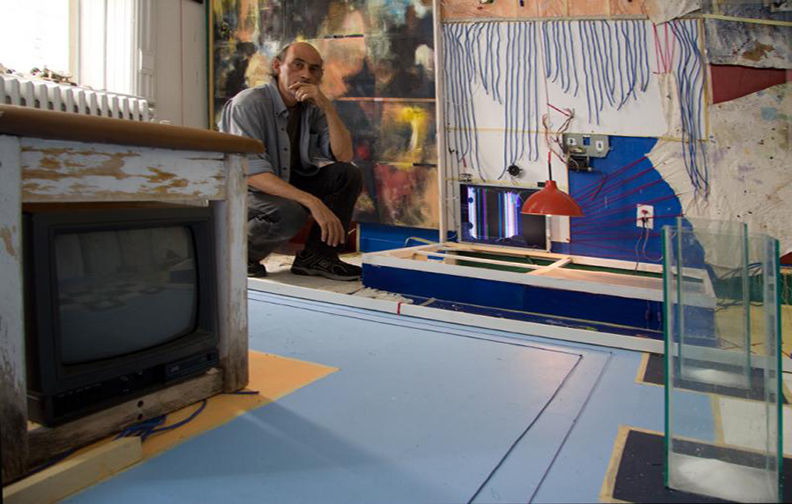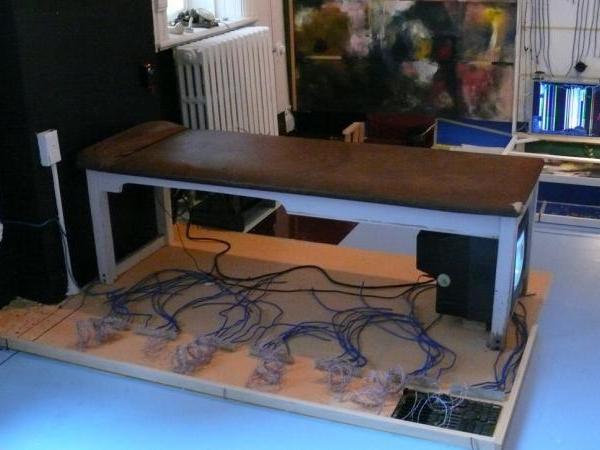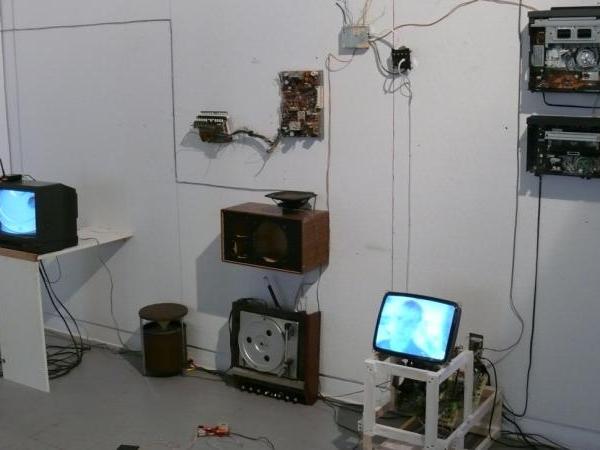
1.6
Vertebrae, Part 2 – The Medium of Television
” …the real is produced from miniaturized cells, matrices, and memory banks, models of control – and it can be reproduced an indefinite number of times from these. It no longer needs to be rational, because it no longer measures itself against either an ideal or negative instance. It is no longer anything but operational.” (Jean Baudrillard)
Overview
An overview of how the medium of Television plays out in the Vertebra, Part 2: The Skinning of Memory (VP2) installation
Plurality of Moments
The philosopher Henri Bergson in his seminal work Matter and Memory states that “however brief we suppose any perception to be, it always occupies certain duration, and involves consequentially an effort of memory which prolongs one into another a plurality of moments” (25). This plurality of moments, which Bergson speaks of implies that memory is not a constant but evolves in relation to what one is experiencing.
The fragmented assemblage of objects and materials in the VP2 installation re-creates this plurality of moments experience with the viewer as he/she moves in and out of the installation’s objects and their imprinted memories.

A critical element within VP2, in relation to this plurality of moments, occurs through the presence of a TV set located beneath a massage bench, which is broadcasting live feed image from another installation entitled the x-Series (VP1) (2009). The x-Series (VP1) is a site-specific installation created prior to VP2 and was located in the media room of the Fine Arts Building at the University of Ottawa, Canada.
The X-Series Live Feed
Several wireless RF cameras were set up between VP2 and the x-Series. One wide angle, live feed camera was located in VP2 which broadcasted to a TV set in VP1. Visitors visiting VP1 could witness the ongoing performative actions of the artist during the construction process of VP2.
Another live camera feed focused on a record player’s turntable in VP1 which was continuously spinning, This live feed was being transmitted back to a TV monitor below the bench in VP2 (Image 15).
The third live feed camera installed within VP1 was hidden in a speaker on the installation’s floor so that if a visitor walked in front of the speaker, they would unexpectedly see their feet and legs interrupt the live video feed being fed from VP2.
The Medium of Television
The power of television to transform personal and sociocultural identity exists in its ability to generate a sense of utopia and well being.
Part of this has to do with the how we (the participants) feel communally connected to each other and the world around us through a centralized point of reference.
In the segment, ‘The Skinning of Memory: Up Close and Personal‘, I discussed how television could sit in as a surrogate Other for my family and friends. I believe that this is still the case despite the proliferation of new technological devices such as computers, cell phones and handheld digital devices.
These devices have not replaced the conceptual and surrogate power of Television. They are in fact, only modified versions of the medium of television, and have more effectively appropriated television’s conceptual and surrogate power including its utopian and utilitarian objectives.
In his essay Of Other Spaces, Michael Foucault explains that “utopias are sites with no real place. They are sites that have a general relation of direct or inverted analogy with the real space of Society. They present society itself in a perfected form, or else society turned upside down, but in any case these utopias are fundamentally unreal spaces” (par. 11).

After completing the X-Series (VP1) (2009), and based on the discovery of the photograph my father had taken of my brother and I (image 18), I began to reflect on the importance of the gesture of placing a TV set into a room filled by other objects – some practical and decorative, others meant to impart personal memories and our family’s socio-cultural roots.
Through my reflections, a question arose as to what role Television and by association, the TV set played in terms of an object, since the relationship of the TV set (as object) changes in respect to itself and the other objects in a room, based on whether it is turned on, or not?
Originally a TV set shared similar traits with other objects. Early TV sets were set in wood grain cabinets with the possibility of placing other objects on and around them, thus disguising them as part of the common living room setting.
However, over time the TV was stripped of its disguise, allowing it to play a prominent role and position amidst the other objects – hovering over the other objects with an anticipation of its engagement. Once engaged, its phosphorous, electronic, blue glow, projected itself onto the fixated gaze of its viewers and then continued to spread over the other objects in the room, transforming the viewer along with the objects’ memory imprints.
Such an event witnessed by someone unfamiliar with the medium of television would perhaps liken their encounter to a science fiction novel.
Next:
The Skinning of Memory: Vertebrae, Part 2 (VP2) – Science Fiction
The Skinning of Memory: Vertebrae, Part 2 (VP2) – Objects
Baudrillard, Jean. Selected Writings. ed. Mark Foster. Stanford University Press. Stanford, CA. 1998. PDF, Web 2010, 2018
Text and ideas originally created and published as part of my MFA Thesis, 2010. Specific segments have been revised and updated for this post. John Naccarato, 2018


